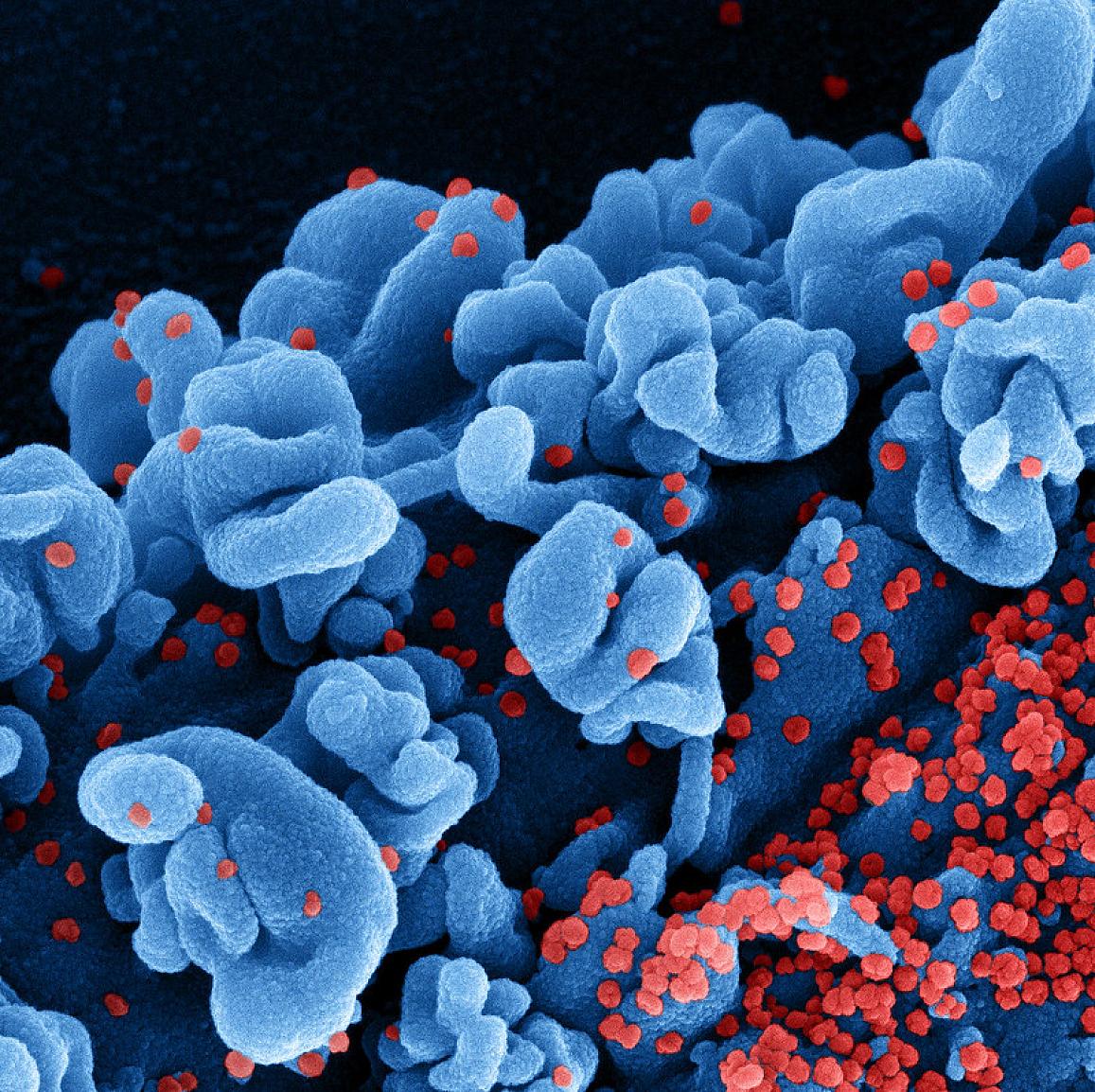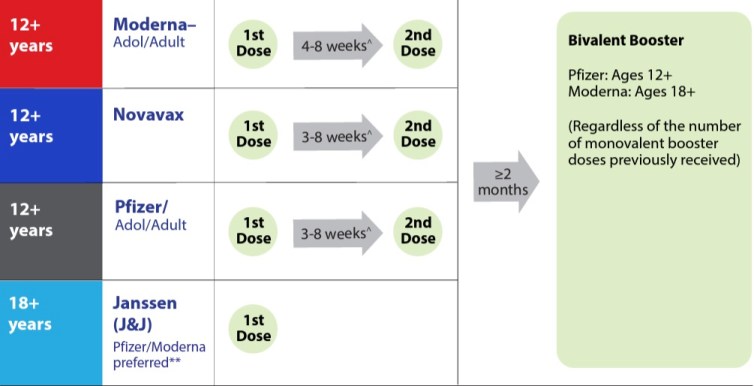New Omicron Vaccine Arrives to Santa Barbara
County in the 'Green' on CDC Scale, but COVID-19 Still Hospitalizes Dozens

Though new cases of COVID-19 continue to afflict people every day, the rate has been slowing since mid-July in California and Santa Barbara County. As well, the new updated vaccine developed for the Omicron BA.4/BA.5 strains has made its way to pharmacies and doctors’ offices in recent days after the Food and Drug Administration approved its use on an emergency basis at the end of August.
The new vaccine — called a bivalent vaccine as it targets the Omicron subvariants and also protects against the original SARS-CoV-2 virus — is popular in Santa Barbara, according to anecdotal accounts from dispensing pharmacies. A pharmacy staff member at the Montecito Vons said they were vaccinating about 100 people a day and could only see people by appointment. Another pharmacy staffer at a CVS in Santa Barbara said the high demand varied by location. Both pharmacies said the Pfizer vaccine was more available than the Moderna vaccine, but that they’d had no trouble obtaining enough vaccine overall.
The vaccines are still free, though some locations may charge an administration fee, said Jackie Ruiz, spokesperson for the Santa Barbara County Public Health Department. Public Health was not making the booster available at the fairgrounds in Santa Barbara and Santa Maria, as they had the earlier rounds of vaccine, but they will be offering vaccinations at community events as they arise, Ruiz assured.
In terms of disease, Santa Barbara County is registering “green” on the Centers for Disease Control’s community scale, which is the lowest level. Based on the most recent days with complete information, the county had 80 new daily cases on average for the week ending September 1, much lower than the average of around 183 in mid-July. In the larger picture, California’s coronavirus numbers have steadily decreased, too, dropping to 6,300 daily average cases on September 9 after closing in on 20,000 new cases a day two months ago. Of course, cases are presumed to be undercounted everywhere due to the availability of home testing.
Hospitalizations remain a more reliable source of information on positivity. Fewer people are ill enough to require hospitalization, but the number reflects the fact that COVID-19 can be a severe disease: In the county, 37 people were in the hospital because of COVID-19 and seven were in an ICU on September 8, compared to about 53 total and six in the ICU in mid-July.
In Santa Barbara County, one person died during the week ending September 8, and 717 people have died of the disease since it broke out here in March 2020. The state is experiencing about 30 deaths per day. (In order to count a COVID-19 death, the state dashboard requires a positive PCR test and also a death certificate listing COVID-19 as the cause or significant factor in the death.)
The vaccination rate in California stands at about 80 percent of the population vaccinated at least once. Among all age groups, the state Department of Public Health iterated, unvaccinated individuals accounted for the highest number of cases, hospitalizations, and deaths. Just over 69 percent of Santa Barbara County residents completed the primary series of vaccinations, and 59.7 percent have also been boosted.
The new bivalent booster arrived with some amount of controversy as clinical trials for it have not yet concluded. According to the FDA, it protects against the Omicron BA.4 and BA.5 sub-variants, which have edged out the other Omicron sub-variants circulating currently. The first clinical studies were completed for a vaccine containing mRNA from the earlier BA.1 lineage of the Omicron variant. The new vaccine contains “mRNA in common between the BA.4 and BA.5 lineages” for Omicron; clinical trials are ongoing for this updated vaccine, and nonclinical data supported the emergency authorization decision. Side effects are said to be similar to the original Pfizer and Moderna vaccines.
The American Medical Association explained in a discussion with Dr. Sandra Fryhofer that the new coronavirus booster was not unlike the annual flu shot, which also changed every year to meet the new flu virus without a full efficacy trial. Animal studies show the Omicron vaccine works, said Dr. Fryhofer, who chairs the AMA’s Board of Trustees and is the AMA’s liaison to the CDC’s Advisory Committee on Immunization Practices. “There’s no clinical trial data specifically for bivalent BA.4, BA.5 boosters in humans yet, but there will be,” she said.
Sign up for Indy Today to receive fresh news from Independent.com, in your inbox, every morning.
“Omicron is more transmissible,” Dr. Fryhofer said. “Our current vaccines don’t work as well against it. Neither do many monoclonal antibody treatments. And that’s why this new bivalent Omicron-specific booster is so important.”
To get the vaccine, people must be at least two months past their last shot. The Pfizer bivalent vaccine is available for people ages 12 and over, and Moderna’s is for those 18 and over, said Jackie Ruiz of County Public Health. She suggested that the vaccines.gov website might have the most comprehensive list of where to get the new Omicron vaccine. More information about vaccines, including vaccines for children, can be found here.

Public Health also continues to advise wearing a good mask when indoors in a public place, in keeping with the newest CDC guidance for COVID-19. The new rules acknowledge the lowered risk from the disease because of the vaccines and medical treatments that have been developed since 2020. The quarantine advice is specific for level of exposure and illness, and as it is somewhat complicated, it is listed in full below. Basically, simple exposure now has a recommendation of masking for 10 days and testing on Day 5. People who are ill should isolate for the first five days, when they are most infectious, and wear a mask around other people.
CDC’s Current COVID Update
Exposure: Guidance for people who are not up to date on COVID-19 vaccines on what to do if exposed to someone with COVID-19. This is consistent with the existing guidance for people who are up to date on COVID-19 vaccines.
• Recommending that instead of quarantining if you were exposed to COVID-19, you wear a high-quality mask for 10 days and get tested on day five.
Illness: Regardless of vaccination status, you should isolate from others when you have COVID-19. You should also isolate if you are sick and suspect that you have COVID-19 but do not yet have test results.
• If your results are positive, follow CDC’s full isolation recommendations.
• If your results are negative, you can end your isolation.
Testing Positive: If you test positive for COVID-19, stay home for at least five days and isolate from others in your home. You are likely most infectious during these first five days. Wear a high-quality mask when you must be around others at home and in public.
• If after five days you are fever-free for 24 hours without the use of medication, and your symptoms are improving, or you never had symptoms, you may end isolation after day five.
• Regardless of when you end isolation, avoid being around people who are more likely to get very sick from COVID-19 until at least day 11.
• You should wear a high-quality mask through day 10.
Other Recommendations
Recommending that if you had moderate illness (if you experienced shortness of breath or had difficulty breathing) or severe illness (you were hospitalized) due to COVID-19 or you have a weakened immune system, you need to isolate through day 10.
Recommending that if you had severe illness or have a weakened immune system, consult your doctor before ending isolation. Ending isolation without a viral test may not be an option for you. If you are unsure if your symptoms are moderate or severe or if you have a weakened immune system, talk to a healthcare provider for further guidance.
Clarifying that after you have ended isolation, if your COVID-19 symptoms worsen, restart your isolation at day zero. Talk to a healthcare provider if you have questions about your symptoms or when to end isolation.
Recommending screening testing of asymptomatic people without known exposures will no longer be recommended in most community settings.
Emphasizing that physical distance is just one component of how to protect yourself and others. It is important to consider the risk in a particular setting, including local COVID-19 Community Levels and the important role of ventilation, when assessing the need to maintain physical distance.
Correction: The new Moderna bivalent booster is for people ages 18 and over; only Moderna’s initial two-shot series with the monovalent vaccine is for those 12 and over.
Support the Santa Barbara Independent through a long-term or a single contribution.



You must be logged in to post a comment.